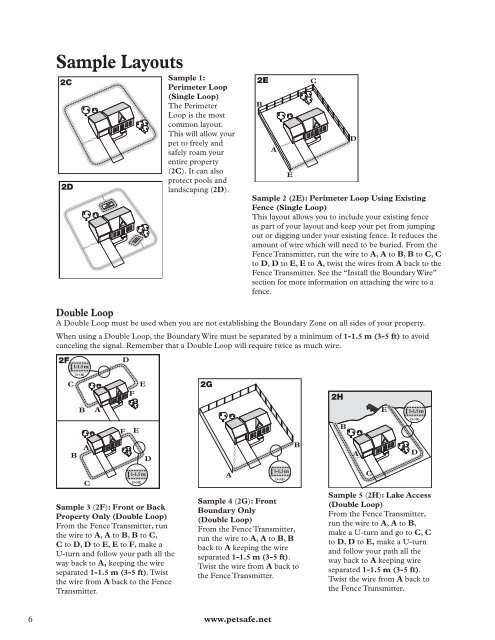Fase - PetSafe Australia
Fase - PetSafe Australia
Fase - PetSafe Australia
You also want an ePaper? Increase the reach of your titles
YUMPU automatically turns print PDFs into web optimized ePapers that Google loves.
Sample Layouts<br />
Sample 1:<br />
Perimeter Loop<br />
(Single Loop)<br />
The Perimeter<br />
Loop is the most<br />
common layout.<br />
This will allow your<br />
pet to freely and<br />
safely roam your<br />
entire property<br />
(2C). It can also<br />
protect pools and<br />
landscaping (2D).<br />
6 www.petsafe.net<br />
B<br />
A<br />
E<br />
C<br />
Sample 2 (2E): Perimeter Loop Using Existing<br />
Fence (Single Loop)<br />
This layout allows you to include your existing fence<br />
as part of your layout and keep your pet from jumping<br />
out or digging under your existing fence. It reduces the<br />
amount of wire which will need to be buried. From the<br />
Fence Transmitter, run the wire to A, A to B, B to C, C<br />
to D, D to E, E to A, twist the wires from A back to the<br />
Fence Transmitter. See the “Install the Boundary Wire”<br />
section for more information on attaching the wire to a<br />
fence.<br />
Double Loop<br />
A Double Loop must be used when you are not establishing the Boundary Zone on all sides of your property.<br />
When using a Double Loop, the Boundary Wire must be separated by a minimum of 1-1.5 m (3-5 ft) to avoid<br />
canceling the signal. Remember that a Double Loop will require twice as much wire.<br />
C<br />
1-1.5 m<br />
B<br />
(3-5 ft)<br />
B A<br />
A<br />
C<br />
D<br />
F<br />
F<br />
E<br />
E<br />
1-1.5 m<br />
(3-5 ft)<br />
D<br />
Sample 3 (2F): Front or Back<br />
Property Only (Double Loop)<br />
From the Fence Transmitter, run<br />
the wire to A, A to B, B to C,<br />
C to D, D to E, E to F, make a<br />
U-turn and follow your path all the<br />
way back to A, keeping the wire<br />
separated 1-1.5 m (3-5 ft). Twist<br />
the wire from A back to the Fence<br />
Transmitter.<br />
A<br />
1-1.5 m<br />
(3-5 ft)<br />
B<br />
Sample 4 (2G): Front<br />
Boundary Only<br />
(Double Loop)<br />
From the Fence Transmitter,<br />
run the wire to A, A to B, B<br />
back to A keeping the wire<br />
separated 1-1.5 m (3-5 ft).<br />
Twist the wire from A back to<br />
the Fence Transmitter.<br />
B<br />
D<br />
A<br />
C<br />
E<br />
1-1.5 m<br />
(3-5 ft)<br />
D<br />
Sample 5 (2H): Lake Access<br />
(Double Loop)<br />
From the Fence Transmitter,<br />
run the wire to A, A to B,<br />
make a U-turn and go to C, C<br />
to D, D to E, make a U-turn<br />
and follow your path all the<br />
way back to A keeping wire<br />
separated 1-1.5 m (3-5 ft).<br />
Twist the wire from A back to<br />
the Fence Transmitter.


